If you are planning a China tour in 2022 & 2023, what are your expectations for your China tour? Are you looking forward to discovering the traditional, natural, and modern charm of China throughout your China tour in 2022 & 2023? If your answer is yes, then this China Dreamland Tour with Yunnan is tailored for you. Starting from Beijing, an ancient capital of China with a lot of historical heritages, you will uncover the secrets of the Chinese royal families by visiting the Forbidden City and the Summer Palace. Transferring to Yunnan, you will admire the amazing terraced fields. Finally arriving in Shanghai, you will be fascinated by the different views on both sides of the Huangpu River. Booking this China Dreamland Tour in 2022 & 2023 and renew your knowledge about China. Take action now!

As you arrive in Beijing, your professional tour guide will pick you up at the airport and transfer you to the hotel for a rest.
As the capital of China, Beijing with a total area of more than 16,000 square kilometers is ten times larger than London and twenty times larger than New York. Beijing once was the capital of six dynasties in history so a great number of royal buildings were built in ancient times and many of them have survived. It enjoys the largest number of heritages in the world, such as the Forbidden City, the Temple of Heaven, the Great Wall, and the Summer Palace. It is also the only city in China where people from 56 ethnic groups live.
After breakfast, you will start your tour in Beijing by visiting Tian’anmen Square in the center of Beijing. Chairman Mao Memorial Hall, Tian’anmen Gate Tower, the Great Hall of the People, the National Museum, the Monument to the People’s Heroes, and many other significant buildings are located here. During the Ming (1368-1644) and Qing (1636-1912) Dynasties, Tian’anmen Square was a closed T-shaped square surrounded by walls on three sides and the civilians could not enter. In the 1950s, the walls were demolished and the square was expanded. Directly opposite the square is the Tian’anmen Gate Tower, which was the main entrance to the ancient Imperial City. Chairman Mao Zedong’s portrait hangs in the middle of the gate tower. There are five arched gateways in the gate tower, of which the largest one in the middle was only for emperors in the Ming and Qing Dynasties.
Then you will look around the Forbidden City (closed each Monday), which is the royal palace of the Ming and Qing Dynasties in China. The Forbidden City is divided into two parts, the Outer Court and the Inner Court. Three halls including the Hall of Supreme Harmony, Hall of Central Harmony, and Hall of Perfect Harmony are located at the center of the Outer Court, where grand ceremonies were held. At the center of the Inner Court lies the Palace of Heavenly Purity, Palace of Union and Peace, and Palace of Earthly Tranquility, which were the palaces where emperors and empresses lived. According to statistics, the Forbidden City houses a total of over a million pieces of art treasures, accounting for one-sixth of the total cultural relics in China.
After lunch, you will visit the Temple of Heaven. Built in 1420 in the Ming Dynasty, the Temple of Heaven was a place where emperors of the Ming and Qing Dynasties worshiped heaven and prayed for their country and people. The temple covers an area of 2.73 million square meters, nearly four times larger than the Forbidden City. The main buildings of the Temple of Heaven include the Hall of Prayer for Good Harvests, the Circular Mound Altar, and the Echo Wall. Every spring, the emperor prayed for a bumper harvest of grain in the Hall of Prayer for Good Harvests. The Circular Mound Altar was the place where the emperor worshiped heaven in winter and prayed for the prosperity of the country and the happiness of the people. The roofs of the Hall of Prayer for Good Harvests, in the beginning, were colored in blue, yellow, and green, which represented the heaven, the emperor, and the people respectively. During the reign of Emperor Qianlong (1736-1795), the colors of the roofs were changed to blue. You will see there are 28 pillars arranged in three circles in this circular hall. The 4 pillars in the inner circle represent the four seasons in a year, the 12 pillars in the middle circle represent the twelve months, and the 12 pillars in the outermost circle represent 12 Shichen (one of the 12 two-hour periods of the day).
Then you will visit the Summer Palace, a royal garden in the Qing Dynasty. The East Palace Gate is the main entrance to the Summer Palace, where the emperor lived and engaged in political activities in summer. Above the gate, there is a golden plaque with Emperor Guangxu’s inscription. It is said that Empress Dowager Cixi was very dissatisfied with the original inscription and ordered to take it off. Later, Emperor Guangxu practiced his writing hard and wrote the Chinese name of the Summer Palace again and again. At last, the plaque with the new inscription of Emperor Guangxu satisfied Empress Dowager Cixi and was approved to be hung up there. In the garden, Renshou Hall is the place where Empress Dowager Cixi and Emperor Guangxu engaged in politics and met foreign guests. Along the north bank of Kunming Lake at the foot of Longevity Hill, you will see the Long Corridor. With a length of more than 700 meters, it is known as the longest corridor in the world. There are more than 14,000 colorful paintings on the beams of the corridor, which are themed on natural landscapes, flowers and birds, and historical stories. Therefore, the Long Corridor has been hailed as “the longest gallery in the world”.
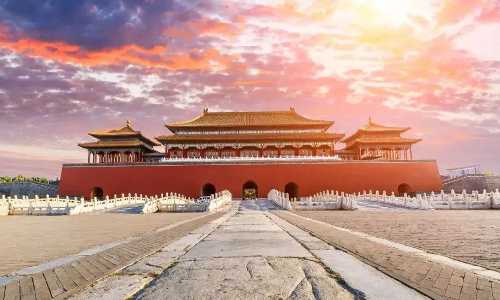
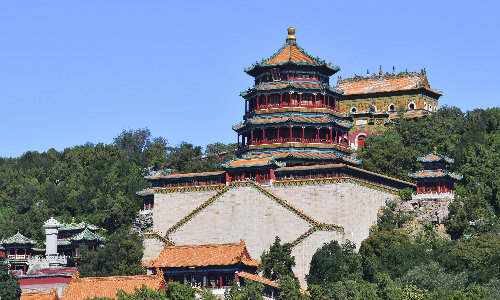
This morning, you will visit the Ming Tombs, the mausoleums of thirteen Chinese emperors in the Ming Dynasty. It is 50 kilometers away in the northwest suburbs of Beijing. It takes about one hour to get there by car. First, you will visit the Sacred Way. The Sacred Way used to be the only way to the Ming Tombs, with a total length of about 7 kilometers. Walking along the Sacred Way, you will see the Great Red Gate with a roof covered with yellow glazed tiles and three entranceways with their respective functions. The central entranceway is for the exclusive use of the deceased emperors and empresses to be carried through, the east one is for the emperor who came to pay respect to the ancestors, and the west one is for the officials accompanying the emperor to pass through. Next, you will visit Ding Tomb, which is the tenth tomb that was built here. It is the mausoleum of Emperor Zhu Yijun and his two empresses. It is worth mentioning that Ding Tomb is the only tomb that has been excavated so far. More than 3,000 pieces of various cultural relics have been unearthed in the underground palace, including the emperor’s Dragon Robe and Golden Crown as well as the empresses’ Phoenix Crowns.
After lunch, you will go to the Badaling Great Wall, 40 kilometers away from the Ding Tomb. We will continue to drive northwest for about 45 minutes. Badaling Great Wall is one of the most significant parts of the Great Wall which is an extremely magnificent defensive building in ancient China. You can take the cable car to the top of the Badaling Great Wall as it stretches along the ridges of high mountains. The defense wall is designed with four basic structures including high walls, battlements, watchtowers, and beacon towers. Whenever the enemy invaded, the soldiers on the wall would light a fire on the beacon tower to transmit military information. Legend has it that in the Western Zhou Dynasty (1046 BC-771 BC), one king ordered to light a fire on the beacon tower close to the capital trying to please his beloved concubine. The concubine rejoiced to see the sight that the troops from all directions rushed to the capital to rescue them. Therefore, the king commanded to light the beacon many times. Later, when the enemy really invaded, the military officials thought the king was making fun again and ignored the beacon. At last, the king was killed by the enemy.
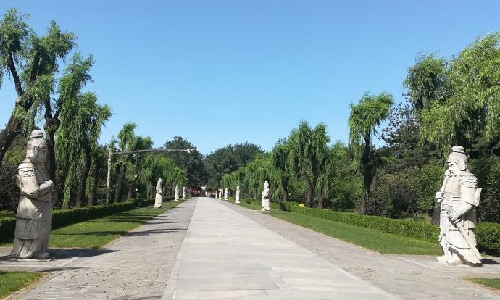
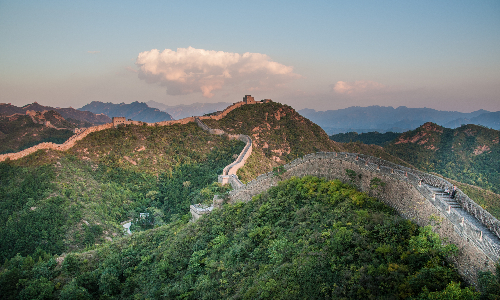
 Kunming
Kunming Today, you will be transferred to the airport and take the estimated flight MU5720 09:15/12:40 to Kunming, the capital city of Yunnan Province, a southwestern province in China.
After arriving in Kunming, you will be picked up by the local guide at the airport. Then, you are going to visit the Stone Forest, which is about 80 kilometers away from the airport. We will drive southeast for about 70 minutes to get there by car. The Stone Forest in Shilin County is your first stop in Yunnan Province. About 300 million years ago, the area around the Stone Forest was a vast ocean. After a long-time geological movement and evolution, a wonder of karst landscapes – Stone Forest has formed. The Stone Forest scenic area contains a lot of large and small stone peaks, lakes, limestone caves, and waterfalls. The steep and upright stone peaks are densely distributed like a forest, among which the highest can reach 40 meters in height. You will also see the stone peaks in different shapes. From certain angles, some look like animals, some like generals and soldiers, and some like flowers. In addition, the popular Chinese TV series Journey to the West was filmed here.
After visiting the Stone Forest, you will stay in Shilin County for one night.
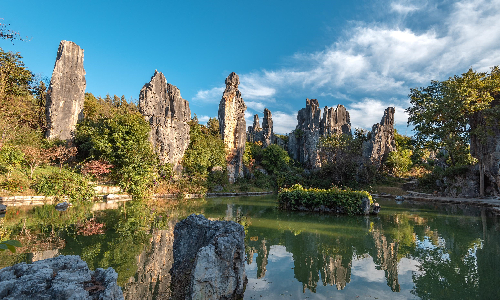
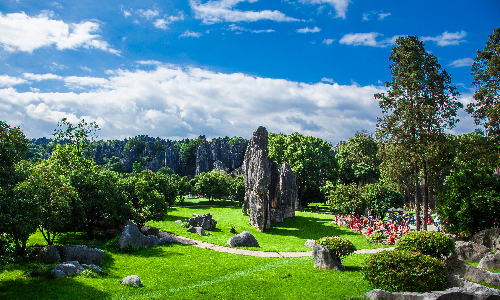
 Jianshui
Jianshui Today, we will drive southward for two and a half hours to Jianshui County, about 200 kilometers away from Shilin County. After arriving in Jianshui County, you will come to visit Jianshui Ancient Town. It is a famous historical and cultural ancient town with more than 50 ancient buildings preserved up to now. The streets in the town are lined with small shops and restaurants where you can buy some souvenirs and have a taste of local specialties. There are four old wells in the town and the residents fetch water from the wells to make a kind of local specialty called Jianshui Tofu (a food made of soybeans), which is famous in China. Then, you will follow your guide to visit the most characteristic attractions in the ancient town.
The first one is the Chaoyang Tower. It is the east gate tower of Jianshui Ancient Town, which was built in 1389 in the Ming Dynasty. In architectural style, this gate tower is similar to Tian’anmen Gate Tower in Beijing, but it is over 20 years earlier than Tian’anmen Gate Tower. The gate tower has three floors and is supported by 48 huge wooden columns. There is a bell of the Ming Dynasty hanging in the tower, which is more than 2 meters high and weighs 3.4 kilograms. Standing on the gate tower, you can overlook the whole view of the Jianshui Ancient Town.
The next one is the Confucius Temple. The temple has a history of more than 700 years, which was built to commemorate Confucius, one of the greatest ideologists and educators in ancient China. The most distinctive building in the temple is Dacheng Hall, which is the center of the Confucius Temple and the main hall for worshiping Confucius. There is a shrine carved by a whole giant stone, which is dedicated to placing the tablet of Confucius. The temple is the best place to experience the Confucian culture. During every Confucius Cultural Festival, from children to old people will gather here to learn Confucian classics.
The last one is Zhu’s Family Garden. It was the residence and ancestral hall built by Zhu Chaoying (also known as Zhu Weiqing, 1871-1927) with his father and his elder brothers in the late Qing Dynasty. Occupying more than 20,000 square meters, the building complex is composed of 42 courtyards and 214 rooms arranged in square patterns. Typically, it is a representative local-style dwelling. Stepping into the garden, you will see an arch with four Chinese characters inscribed on it. It was Zhu’s family instructions that intended to warn the younger generations to be discreet in word and deed. The famous pictures of 24 stories of filial piety are engraved on the doors of the ancestral hall, which also reminded Zhu’s younger generations to treat their elders with filial respect. There is an old well in the yard, which is the only source of the family’s living water. There are deep rope marks on the edge of the well. There is a small hole in the well. If the water level in the well is higher than the hole, the water will flow out of the small hole and to every corner of the garden. That means Zhu’s residence would be flooded with money. In Addition, there is also a photo exhibition on 100 years’ history of Zhu’s family, where you will learn the history of this large and wealthy family.
Accommodation will be arranged in Jianshui County, where you will find a home from home.
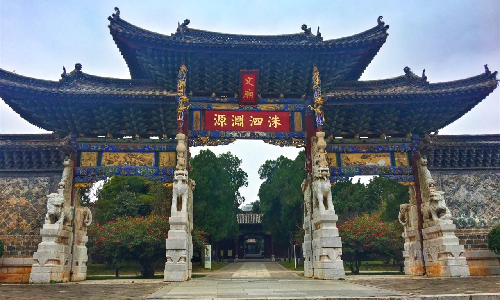
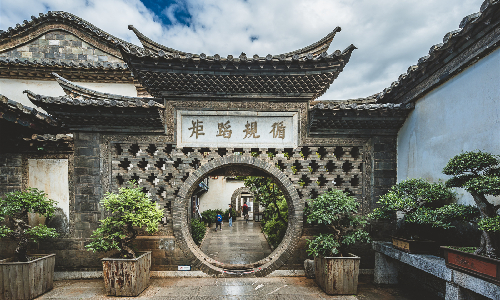
 Yuanyang
Yuanyang In the morning, we will leave Jianshui County and drive southward for two hours to Yuanyang County, which is about 80 kilometers away. Yuanyang County is a hilly county. For thousands of years, the people living here have improved the farming environment in the hilly areas by transforming the hills into arable lands – terraced fields. The terraced field, built around the hillsides, is the artificial farmland on which rice is planted. There is a total of more than 11,000 acres of terraced fields in Yuanyang County. After arriving, you will first visit Yuanyang Rice Terrace. It is mainly reclaimed by the Hani people following the topography. It is just like a Chinese landscape painting that has been “painted” continuously by the Hani people for more than 1,300 years.
In the afternoon, you will visit the Bada Rice Terrace, which is also a recommended place to enjoy the beauty of the terrace and the village scenery. The terraces extend from the feet of the hills hundreds of meters high above sea level to the tops at the altitude of over two thousand meters. The continuous terraces are like huge ladders directly reaching the sky. Standing on the Bada Viewing Platform, you can see more than 10 square kilometers of terraced fields encircling the hills like ribbons.
As night falls, you will stay in Yuanyang County for one night.
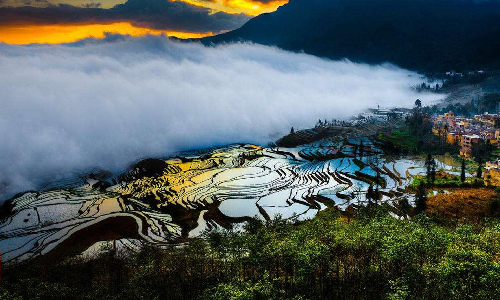
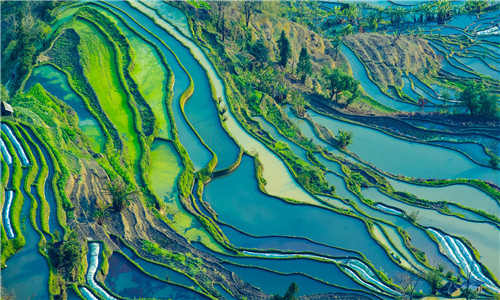
This morning, you will enjoy the scenery of Duoyishu Rice Terrace. Duoyishu is a beautiful village inhabited by the Hani people. It is the best place in Yuanyang County to see the sunrise and shoot the sea of clouds. The terraced fields in Duoyishu are surrounded by mountains on three sides. The terrace here is more than 1,700 meters high above sea level. The color of the terraces changes at different times of the day. The rising sun shining on the terraces in the morning makes the terraces full of water look like thousands of reflective mirrors. When the sun dispels the fog, golden terraces can be seen here. The fabulous terrace landscapes here attract many visitors and photographers who come here to watch the sunrise and take photos.
Then, you will come to Aichun Village. Lying on the hillside and surrounded by the terraces, Aichun Village is a traditional village that accommodates over 60 families of the Hani people. The folk house of the Hani people enjoys an interesting name called Mushroom House. This kind of house is built with grass as the roof and adobe as the wall, just like a mushroom. This kind of structure makes the house warm in winter and cool in summer. The Mushroom House is generally designed into three floors. The first floor is mostly used for keeping livestock, the second floor is used for living, and the top floor is used for storing grains because it has a good ventilation effect.
After lunch, you will visit Azheke Village, another well-preserved ancient Hani village. Azheke means lush forests in the Hani language. The buildings in Azheke Village are also mushroom houses. Almost every household can see the vast terraces around the village.
Then you will continue to visit the last terrace attraction – Laoyingzui Rice Terrace. It is also known as Red Terrace because there is a lot of red duckweed growing in the terraces, bringing a unique scene. Laoyingzui Rice Terrace is famous for its colorful terraces, with red duckweed and green water grass growing floating on the water of the terraces. At sunset, the terraces are colorful, just like ribbons dancing.
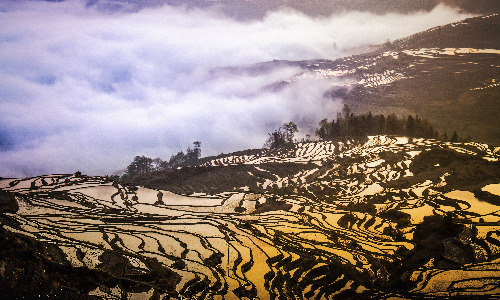
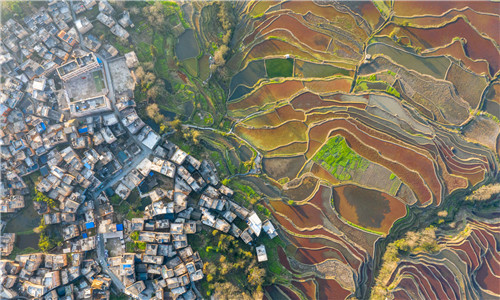
 Dali
Dali After breakfast, you will be transferred to the railway station and take the estimated train G8664 08:07/10:21 to Dali.
Your tour in Dali will start from Dali Ancient Town. From the 8th century to the 12th century, Dali is one of the most prosperous areas in Southeast Asia. The streets in the ancient town are mostly paved with gray bricks and the houses are built in a wooden structure with roofs covered with tiles. Many cultural relics and historic sites are well preserved in the ancient town. There are still a large number of buildings built in the Ming and Qing Dynasties, including towers, temples, academies, Catholic and Christian churches, and other ancient buildings. Of the four ancient towers, Wuhua Tower was the place where the king of Dali feasted guests in the old times. Now it is the most significant landmark in the town and it will be lightened in the night. The Wenxian Tower was built during the reign of Emperor Kangxi in the Qing Dynasty. It is a two-story building with typical Bai architectural features.
Then you will visit the Three Pagodas Temple, 1.5 kilometers northwest of Dali Ancient Town. The temple faces Erhai Lake in the east with its back against Cangshan Mountain in the west. It was a royal temple of the Dali Kingdom. Entering the temple and going along the central axis, you will see three white pagodas in the temple with the largest one in the middle and two smaller ones on both sides. The largest pagoda is 69 meters high with 16 floors. It is said that the three pagodas were built to suppress the floods caused by Erhai Lake.
Then, you will come to Erhai Lake, about 5 kilometers east of the Three Pagodas Temple. It is the second largest freshwater lake in Yunnan Province. It is called “Erhai” because of its shape like a human ear. “Moon in Erhai Lake” is a wonderful view at Erhai Lake. On the night of every Mid-Autumn Festival (the 15th day of the eighth month in the Chinese lunar calendar), Bai families living around the Erhai Lake will row boats on the Erhai Lake to enjoy the golden moon reflected in the water. Legend has it that a princess in Heaven envied the happy life in the secular world so she went down to a fishing village near the Erhai Lake to marry a fisherman. In order to help all fishermen to live a well-fed life, the princess sank her mirror into the lake, which could bring out the fish clearly. In this way, the fishermen could catch more fish. Later, the mirror turned into a golden moon in the lake, shining brightly to help the fishermen generation after generation.
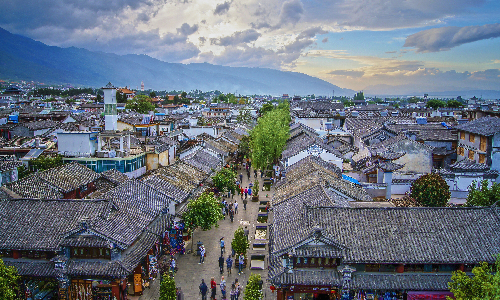
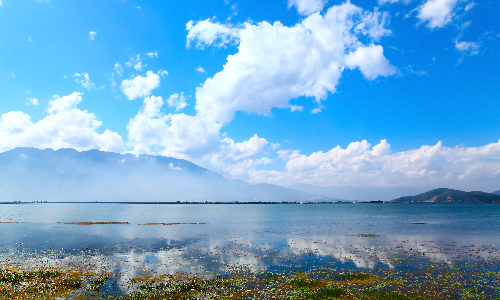
 Lijiang
Lijiang Today we will drive northward for about two and a half hours to Lijiang, about 180 kilometers away from Dali. Lijiang is a famous tourist city in Yunnan Province, where many ethnic groups live together. Apart from the Han nationality, there are 12 indigenous ethnic minorities including Naxi nationality, Yi nationality and so on. There are over a hundred tourist attractions, such as Lijiang Ancient Town, Jade Dragon Snow Mountain, and Black Dragon Pool.
On the way to Lijiang, we will visit Xizhou Ancient Town, 18 kilometers north of Dali Ancient Town. It is a famous historical and cultural town with a history of more than one thousand years. It is a town inhabited by the Bai nationality and it has the most and best-preserved Bai residential buildings. There are hundreds of Bai residential buildings with their own characteristics constructed in the Ming and Qing Dynasties. Here, you will be amazed by these magnificent residential buildings and learn something about the Bai nationality.
When arriving in Lijiang, we will visit Lijiang Ancient Town. The town was founded in the late 13th century. A river flows throughout the town, forming a unique landscape. The architectural design combines the styles of the Han nationality, the Tibetan nationality, and the Bai nationality, forming its unique architectural style. A large number of bridges spanning over the river is the biggest feature of the town. According to statistics, there are 365 bridges of different sizes in the town and many bridges built in the Ming and Qing Dynasties are well preserved. These bridges are designed in different forms, such as stone arch bridges and wooden bridges.
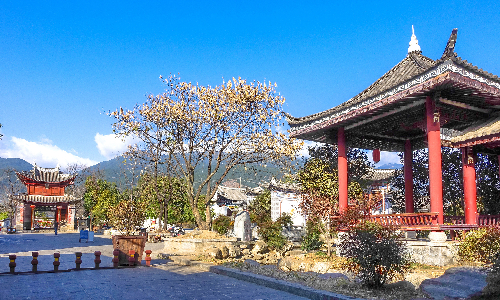
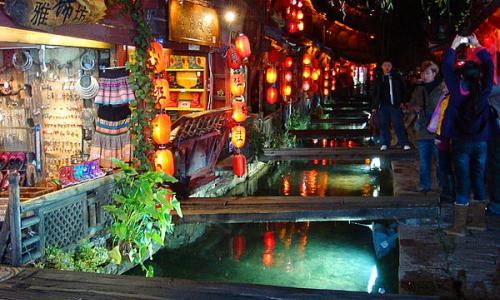
This morning, you will pay a visit to Baisha Village where you can experience the profound culture of the Naxi nationality. Baisha Village is located at the south foot of Jade Dragon Snow Mountain, 12 kilometers north of Lijiang Ancient Town. It is the earliest settlement of the Naxi people in Lijiang. Up to now, the original appearance of the village has been preserved. Naxi residents wearing colorful ethnic costumes can be seen everywhere in the village. There are some shops on the streets selling exquisite traditional handicrafts, embroideries, and costumes. Besides, traditional Naxi folk houses stand on the streets orderly. Most importantly, the must-see things in Baisha Village are the famous Baisha Murals distributed in the village. Baisha Murals are excellent works created in the Ming and Qing Dynasties. They have a history of more than 500 years and they are the artistic heritages of Dongba culture. Dongba culture is the unique culture of the Naxi nationality, including Dongba characters, scriptures, paintings, music, dance, and various sacrificial ceremonies. The painters incorporated Tibetan Buddhism, Han Buddhism, and Taoism into local Dongba culture to create such diversified artistic works – Baisha Murals.
After lunch, you will visit the Black Dragon Pool, which is located in Black Dragon Pool Park in Lijiang. There are many ancient buildings in the park. Standing on the bridge in the park, you will see the Jade Dragon Snow Mountain. There is a beautiful legend about the Black Dragon Pool. The young Dragon King (the god of rain) in Black Dragon Pool fell in love with the daughter of the king of a nearby mountain, and often came to the mountain secretly to see her. However, his action angered the Mountain King who didn’t allow them to meet again. Because of sadness, the young Dragon King got slack at his work and no longer brought rain to local villagers. After villagers learned the reason, they sacrificed to the Mountain King to pray for rain, instead of the Dragon King, which aimed to persuade the Mountain King to allow their marriage. Approved by the Mountain King, they finally got married and lived a happy life.
Then you will go to Dongba Culture Museum. The museum now has a collection of more than 12,000 pieces of cultural relics. When you enter the museum, you will be amazed by the Naxi Pictographic Relief Sculpture, a relief sculpture wall with Naxi hieroglyphics on it. Naxi hieroglyphs are the characters still used by the Naxi people in China, which is also called Dongba Character. There are more than 1,500 characters in the Naxi hieroglyph, which is the only living pictograph that is still being used in the world today.
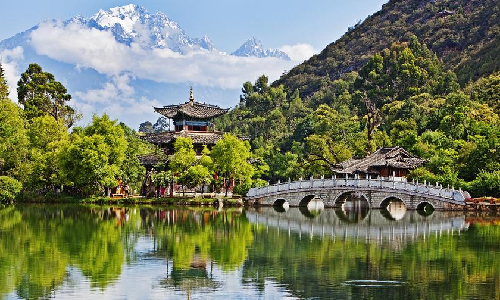
 Shangri-La
Shangri-La This day we will drive northward to Shangri-La, about 180 kilometers away from Lijiang. The whole journey will take about 3 hours.
Shangri-La is one of the most beautiful places in China. Hundreds of millions of years of geological movement in Shangri-La has created complicated geography. Here, the wonderful scenery can be seen everywhere, such as plateaus, sacred snow-capped mountains, and deep canyons. There are nearly 1,000 snow-capped mountains over 4,000 meters above sea level. There is also the Dagu Glacier, one of the three major glaciers in the world, and Midui Glacier, the lowest glacier in the world. Apart from countless lakes, there are large tracts of grasslands.
On the way to Shangri-La, we will visit Stone Drum Town. The town is located 60 kilometers west of Lijiang Ancient Town. We will drive about an hour to get there. It is said that during the period of the Three Kingdoms (220-280), when Zhuge Liang (the prime minister of the Shu Kingdom) marched south, he set up a stone drum here, so this town was named after it. When the Yangtze River flows southward and arrived in Stone Drum Town, it turned sharply to the northeast after being blocked by a cliff, forming a huge V-shaped turn. It has become a famous spectacle, known as the First Bend of the Yangtze River.
After visiting Stone Drum Town, you will have a thrilling experience at Tiger Leaping Gorge. As one of the deepest canyons in the world, this gorge is about 3,900 meters deep, with Yulong Snow Mountain at an altitude of 5,596 meters on the east and Haba Snow Mountain at an altitude of 5,396 meters on the west. Tiger Leaping Gorge was named after the legend that a tiger once jumped from the Yulong Snow Mountain by virtue of the rock in the middle of the river to Haba Snow Mountain. You can still see that rock in the river now.
After the Tiger Leaping Gorge, we will continue driving to Shangri-La. Upon arriving in Shangri-La, you will be transferred to the hotel for a good rest.
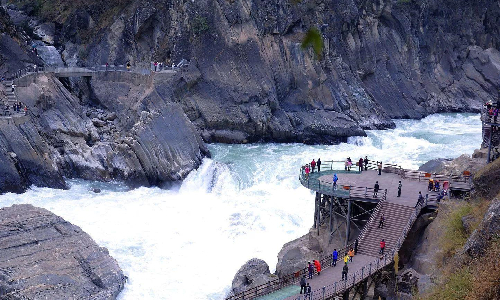
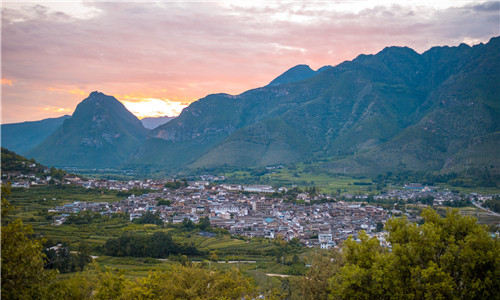
If you are interested in Buddhist culture, you need to pay special attention to our visit to Songzanlin Monastery. It is the largest Tibetan Buddhist monastery in Yunnan Province. The monastery faces south and is a five-story Tibetan-style building. It is located on a high-altitude mountain so you need to slow down to ascend the stairs. Along the way, you will see monks’ residences and two main halls at the highest point. Zhacang Hall is the place for monks and pilgrims to worship and chant, which can accommodate 1,600 people. Songzanlin Monastery is known as the Tibetan Art Museum for its numerous treasures, such as bronze statues of Dalai Lama (religious leader of Tibetan Buddhism), Buddhist scriptures, Buddhist scroll paintings, and gold censers. The buildings are ornamented with bright cloth strips in five colors, namely, red, white, blue, yellow, and green. In Tibetan Buddhism, the five colors symbolize fire, cloud, sky, earth, and water respectively.
After lunch, the guide will show you around Potatso National Park. The park lies on the highland and the altitude ranges from 3,600 meters to 4,200 meters. It still maintains a complete primeval forest ecosystem. The spruce trees in the forest can reach 30 meters high and there are ancient poplars over 500 years old. Matsutake is commonly seen in this primeval forest, which is a treasure that local Tibetan people depend on for a living.
Then you will pay a visit to a Tibetan Family to experience the local Tibetan life. When you walk into a Tibetan family, a Tibetan man will present you with a Hada while a Tibetan woman will present you with a glass of highland barley wine. You will enjoy delicious Tibetan food while watching Tibetan performances, like dancing and singing.
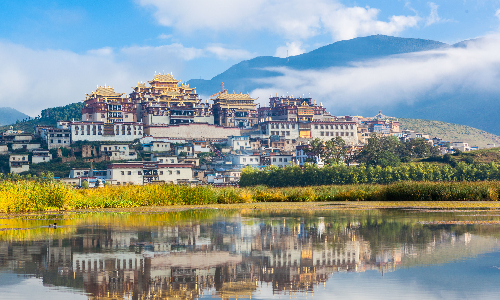
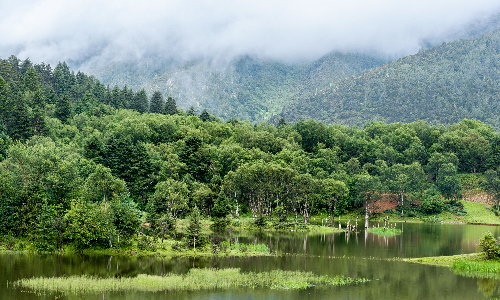
 Shanghai
Shanghai Your wonderful tour in Yunnan will come to the end. No activities will be arranged in the morning, so you can have a rest and prepare for your following trip to Shanghai.
After lunch, the local guide will transfer you to the airport and you will take the estimated flight MU7891 15:55/21:55 to Shanghai. Your Shanghai guide will meet you at the airport and take you to your hotel.
Your tour in Shanghai will start from the Jade Buddha Temple. The temple was named after a jade Buddha statue enshrined in the temple. This sitting statue of jade Buddha is 1.95 meters high and is carved from a whole piece of jade. The cassock’s edge of the Buddha statue and the armlet around its right arm are decorated with more than 100 pieces of treasures, such as jadeite and agate. The whole Buddha statue is glittering and translucent and the appearance of the Buddha statue is serene and kind. Besides, taking a look at the magnificent halls on the central axis of the temple is a traditional way to visit the Jade Buddha Temple.
Yu Garden (closed each Monday) is one of the attractions that you cannot miss in Shanghai. It was originally a private garden in the Ming Dynasty with a history of more than 400 years. There are many buildings in the garden, of which the main buildings are Sansui Hall, Wanhua Chamber, Dianchun Hall, Huijing Tower, Yuhua Hall, and so on. Yuhua Hall once was the study of the master. The owner of this garden loved exquisite jade very much, so he built this hall for the convenience of appreciating them while reading books. In south of Yuhua Hall, there is one treasure of the garden, Exquisite Jade Rock, with a height of 3 meters. It has been known as one of the most famous rocks in southern China.
In the afternoon, you will go up the Shanghai Tower to enjoy a panoramic view of Shanghai. This tower is a super high-rise landmark building in Shanghai, with 127 floors and a total height of 632 meters. The building designed by Gensler architectural design firm of America is spiraling upward. The 118th-floor sightseeing hall of Shanghai Tower is a perfect place for overlooking the Oriental Pearl TV Tower, Jinmao Tower, and the Shanghai World Financial Center around it, as well as the Bund, the Expo Park, and the Huangpu River below.
Then you will have close contact with the Bund, which is one of the most recognizable symbols of Shanghai. It is a waterfront area on the west bank of the Huangpu River and there are dozens of historical buildings on it, which has been called the “World Architecture Expo”. The Bund used to be a concession area of Great Britain after 1844 in the Qing Dynasty. In those days, consulates of various countries were mostly concentrated here. In the late 19th century, many foreign banks and other financial institutions were established on the Bund, known as the financial street in Shanghai and equivalent to the Wall Street in the US. Because of the rich historical value and the geographic location of the Bund, owning a small piece of land on the Bund is not only a sign of wealth but also a sign of honor.
In the end, you will take a walk along Nanjing Road with the laudatory name of “the first commercial street in China”. You can directly reach this street from the Bund. Built in 1851 after Shanghai opened its port, it is the earliest commercial street. Besides, it is also the birthplace of various kinds of fashionable and advanced things in China, such as the earliest gaslights, electric lights, trams, foreign-funded foreign companies, department stores, and escalators. This commercial street gathers more than 50 time-honored brands, which are not only favored by foreign tourists but also deeply loved by the local people. For example, you can buy some local food in the First Foodhall, Shen Da Cheng Food Store, and Tai Kang Food Store. In addition to the old Chinese brands, there are also modern flagship stores, such as Huawei’s largest flagship store in the world, which covers an area of nearly 5,000 square kilometers with three floors. The combination of traditional and modern decorative styles makes it the most dazzling existence on the Nanjing Road.
Optional Activity:
You are also recommended to go sightseeing on the Huangpu River, the mother river of Shanghai. In the evening, the buildings on both sides of the river will display a light show. You can take the wonderful Huangpu Night River Cruise to enjoy the scenery on both sides for about one hour. During the tour, the buildings with colorful lights on both sides of the river are displayed in front of you. One side is the “World Architecture Expo” built in the old days and the other side is dotted by modern buildings. It has become the most attractive tourist activity in Shanghai.
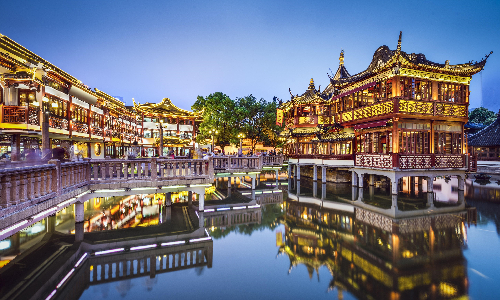
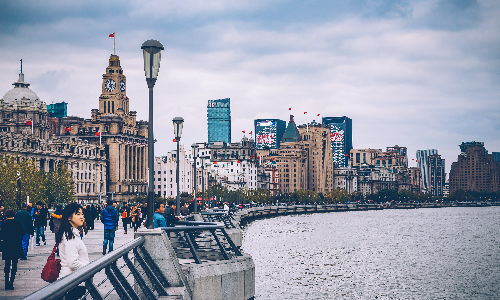
Your wonderful China Dreamland Tour in 2022 & 2023 will come to an end. You will be transferred to Shanghai airport according to your schedule. We wish you all the best! Please feel free to contact us with any questions you may have.
Author: Tianhua Liu
Proofreader: Vivian Zhou
| City | Five Star hotel list | Four Star hotel list |
|---|---|---|
| Beijing | Sunworld Dynasty Hotel Beijing Wangfujing | Sunworld Hotel Wangfujing |
| Kunming | Grand Park Kunming | UChoice Hotel |
| Jianshui | Lin'an Hotel | Hanlinyuan Hotel |
| Yuanyang | Oness Resort Yuanyang Terrace | Oness Resort Yuanyang Terrace |
| Dali | The One Hotels & Resorts | Landscape Hotel |
| Lijiang | Wonderport International Hotel | Lijiang Wangfu Hotel |
| Shangri-La | Paradise Hotel | Ri Yue Xing Cheng Hotel |
| Shanghai | Ocean Hotel Shanghai | Courtyard by Marriott Shanghai Central |
 |
![]() About your child or infant, please contact us for a discounted price.
About your child or infant, please contact us for a discounted price.



We started with a few days in Beijing & ended in Shanghai, from where we visited the Forbidden City and Great Wall. In between we visited Terra Cotta Warriors Museum, Panda Base, Shanghai Disneyland.

We had a wonderful holiday in China which will remain long in the memory. China is a breathtakingly beautiful country full of splendid temples and palaces, mountains and rivers, peaceful rural scenes and bustling shopping streets.
 QUICK ENQUIRY
QUICK ENQUIRY